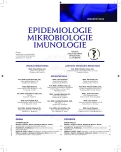The prevalence of nasal carriage of Staphylococcus aureus aureus and methicillin-resistant S. aureus (MRSA) among general medicine students of the Palacky University Olomouc
Authors:
O. Holý 1; J. Vlčková 1; I. Matoušková 1; M. Kolář 2
Authors‘ workplace:
Ústav preventivního lékařství LF UP v Olomouci
1; Ústav mikrobiologie LF UP v Olomouci
2
Published in:
Epidemiol. Mikrobiol. Imunol. 64, 2015, č. 2, s. 98-101
Category:
Original Papers
Overview
Introduction:
Staphylococcus aureus is one of the major agents of both healthcare - and community-associated infections. Nasal carriage of S. aureus has been reported in approximately 37% of healthy persons.
Objectives:
1. To investigate the prevalence of nasal carriage of S. aureus and MRSA in healthy persons of the age group 18-26 years (general medicine students of the Palacký University Olomouc). This type of information is not available in the Czech Republic.
2. To find whether the prevalence of nasal carriage strains of S. aureus and MRSA varies over the years of studies.
3. To compare the Year 1 (baseline) and Year 5 (after a long, close contact with the indoor environment of health-care facilities) general medicine students for nasal carriage of S. aureus and MRSA strains.
Materials and methods:
The prevalence study was conducted for over 12 months in 2012 and 2013. Nasal swabs were taken from the general medicine students participating in the study. Each subject was sampled once.
Results:
In total, 307 samples were collected: 206 samples from the Year 1 students and 101 from the Year 5 students. Sixty-one (about 32%) Year 1 students and 32 (30%) Year 5 students were positive for S. aureus. Of them, 94 (30.6%) were males and 213 (69.4%) were females.
Conclusions:
The observed prevalence of nasal S. aureus carriage is consistent with the literature data. No statistically significant difference in the prevalence of nasal carriage of S. aureus was found between the Year 1 and Year 5 general medicine students.
Keywords:
screening – nasal carriage – Staphylococcus aureus – MRSA – surveillance
Sources
1. Petráš P, Machová I, Rysková L, et al. Cases of menstrual toxic shock syndrome in the Czech Republic in 1997–2011. Epidemiol Mikrobiol Imunol, 2011;60 : 161–166.
2. Crémieux AC, Saleh-Mghir A, Danel C, et al. α-Hemolysin, not Panton-Valentine leukocidin, impacts rabbit mortality from severe sepsis with methicillin-resistant Staphylococcus aureus osteomyelitis. J Infect Dis, 2014;209 : 1773–1780.
3. Jungk J, Como-Sabetti K, Stinchfield P, et al. Epidemiology of methicillin-resistant Staphylococcus aureus at a pediatric healthcare system, 1991–2003. Pediatr Infect Dis J, 2007;26 : 339–344.
4. Kluytmans J, van Belkum A, Verbrugh H. Nasal carriage of Staphylococcus aureus: epidemiology, underlying mechanisms, and associated risks. Clin Microbiol Rev, 1997;10 : 505–520.
5. Surveillance report – Antimicrobial resistence surveillance in Europe 2012, European Centre for Disease Prevention and Control (ECDC), Stockholm, 2013; Dostupné na www: http://www.ecdc.europa.eu/en/publications/Publications/antimicrobial-resistance-surveillance-europe-2012.pdf
6. Munckhof WJ, Nimmo GR, Schooneveldt JM, et al. Nasal carriage of Staphylococcus aureus, including community-associated methicillin-resistant strains, in Queensland adults. Clin Microbiol Infect, 2009;15 : 149–155.
7. Bischoff WE, Wallis ML, Tucker KB, et al. Staphylococcus aureus nasal carriage in a student community: prevalence, clonal relationships, and risk factors. Infect Control Hosp Epidemiol, 2004;25 : 485–491.
8. Stubbs E, Pegler M, Vickery A, et al. Nasal carriage of Staphylococcus aureus in Australian (pre-clinical and clinical) medical students. J Hosp Infect, 1994;27 : 127–134.
9. Wenzel RP, Perl TM. The significance of nasal carriage of Staphylococcus aureus and the incidence of postoperative wound infection. J Hosp Infect, 1995;31 : 13–24.
10. Zanger P, Nurjadi D, Gaile M, et al. Hormonal contraceptive use and persistent Staphylococcus aureus nasal carriage. Clin Infect Dis, 2012;55 : 1625–1632.
11. Slow S, Priest PC, Chambers ST, et al. Effect of vitamin D3 supplementation on Staphylococcus aureus nasal carriage: a randomized, double-blind, placebo-controlled trial in healthy adults. Clin Microbiol Infect, 2014;20 : 453–458.
12. Mehraj J, Akmatov MK, Strömpl J, et al. Methicillin-Sensitive and Methicillin-Resistant Staphylococcus aureus Nasal Carriage in a Random Sample of Non-Hospitalized Adult Population in Northern Germany. PLoS One, 2014;9:e107937.
13. Ishihara K, Saito M, Shimokubo N, et al. Epidemiological analysis of methicillin-resistant Staphylococcus aureus carriage among veterinary staff of companion animals in Japan. J Vet Med Sci, 2014;[Epub ahead of print].
14. Bierowiec K, Płoneczka-Janeczko K, Rypuła K. Cats and dogs as a reservoir for Staphylococcus aureus. Postepy Hig Med Dosw (Online), 2014;68 : 992–997.
15. Messenger AM, Barnes AN, Gray GC. Reverse zoonotic disease transmission (zooanthroponosis): a systematic review of seldom-documented human biological threats to animals. PLoS One, 2014;9(2):e89055.
16. Pazderková J, Krejčí J, Dlouhý P. Fifty years with MRSA. An attempt to evaluate methods used to control infections caused by methicillin-resistant Staphylococcus aureus (MRSA). Klin Mikrobiol Infekc Lek, 2012;18 : 132–141.
Labels
Hygiene and epidemiology Medical virology Clinical microbiologyArticle was published in
Epidemiology, Microbiology, Immunology

2015 Issue 2
Most read in this issue
- The possibilities of zoonotic transmission of rotaviruses
- Hepatitis E – overview of the latest knowledge
- The prevalence of nasal carriage of Staphylococcus aureus aureus and methicillin-resistant S. aureus (MRSA) among general medicine students of the Palacky University Olomouc
- Toxoplasmosis in immunocompromised patients
